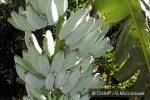Cook Islands Biodiversity Database
Species Page
Musa (AAB group)
Meika Mario / Meika TaruāBanana
Multimedia & Additional Resources
| Type | Description | Download |
| Fruit and leaves (Blue-green banana) | 72KB | |
| Flower, fruit, leaves and trunk (Red Banana) | 54KB | |
| Fruit and leaves (Red Banana) | 48KB |
General Information
Cook Islands Distribution
| Southern Group: Present Makatea: Present | ||||||||
RR |
MG |
AT |
MK |
MT |
AK |
PL |
TK |
MN |
++++ |
+++ |
++++ |
+++ |
P |
+++ |
P |
- |
- |
| Northern Group: Present | |||||
TN |
MH |
RK |
PK |
NS |
SW |
+++ |
P |
P |
+++ |
P |
- |
Pests & Hosts
| Relationship | Pests |
| Herbivorous pest and Disease Vector | Pentalonia nigronervosa, |
| Pathogen of bananas | Mycosphaerella fijiensis, |
Scientific Taxonomy
Musa (AAB group) Linnaeus
SYNONYMS: Musa paradisiaca; Musa X paradisiaca; Musa acuminata X Musa balbisiana; Musa X sapientum; Musa paradisiaca paradisiaca [plantain, cooked]; Musa paradisiaca sapientum [eating banana]
TAXONOMY: PLANTAE; ANTHOPHYTA (=Angiospermae); LILIOPSIDA (=Monocotyledones); ZINGIBERIDAE; Zingiberales; MUSACEAE. COMMENT: hybrid of $Musa acuminata@ X @Musa balbisiana@
More Information
GENERAL NOTE: The AAB group divides into two basic groups: cooking bananas (plantains, mainly 'French Plantain') and dessert or eating banana (mainly 'Mysore' and 'Silk'). This basic division is reflected in the Cook Islands: Taruā/Rokua (the cooking bananas) and the Mario (eating bananas, including the Lady's-fingers Banana). The now mainly extirpated Polynesian Introduced bananas also belonged to this group, and they probably developed by hybrisation in the Philippines where Musa balbisiana is native and Musa acuminata was in ancient cultivation. Close relatives of the early Polynesian bananas have not been found elsewhere in southeast Asia nor in New Guinea.
Vouchers & References
Vouchers:
Pukapuka: fieldspecimen, 2/2004, G.McCormack with ID as Musa (AAB group).
References:
p.1465 Wagner et al.- Flowering Plants of Hawaii
p.249 Neal - In Gardens of Hawaii
p.762 Royal Hort. Soc. Index of Garden Plants
p.470 Tropica
p.1/183 A.C.Smith - Flora Vitiensis Nova
p.299 A+R Cheeseman - Flora of Rarotonga
p.32 A+R Wilder - Flora of Rarotonga
p.379e Whistler - Ethnobotany of the Cook Islands
Data Update History (information):
zTX, zB02, zM02, zD02
Web Resources
Citation Information
McCormack, Gerald (2007) Cook Islands Biodiversity Database, Version 2007.2. Cook Islands Natural Heritage Trust, Rarotonga. Online at http://cookislands.bishopmuseum.org. ![]()
Please refer to our use policy.

